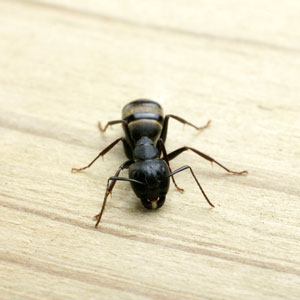Carpenter Ants Can Infest Perfectly Dry Wood
By Chris Williams on March 13, 2014.

Question
When my husband was rerunning some electrical lines inside the dining room walls, he found an area of damaged wood on one of the studs. Unfortunately, he also saw some large black ants in the void which I assume are carpenter ants. Don’t carpenter ants just attack wet wood or where there have been leaks? This area is, and always has been, totally dry.
Answer
That’s a common misconception. It’s true that carpenter ants usually infest wood that has been water-damaged, but it’s not always the case. They’re perfectly capable of chewing into dry wood as well. The ants prefer wood that has been wet or moldy since it is softer and therefore easier to excavate galleries for their nest. They will initially move into a home where there has been a roof leak, plumbing leak, condensation, or a drainage problem. The wood may still be damp or long since dried. Once carpenter ants have established a nest in that area, they can move on to infest totally dry wood nearby.
Like termites, carpenter ants damage wood in homes. Unlike termites, they don’t actually feed on the wood. They just excavate it to create hollows or galleries inside the wood that they use as nests for their young.
Look for the Ants’ “Dump Piles”
Carpenter ants like to keep a clean home. Their galleries are very clean and smooth to the touch. They use their mandibles to tear out pieces of wood, but then they need to get rid of that wood, so they dump it to the outside. If you look closely, you might see slit-like openings in the wood where they push debris out of the nest. Below the nest, you might see a characteristic carpenter ant “dump pile.”
If you look at the pile under magnification, you will see that it contains bits of chewed wood, pieces of insulation or other debris that were in their way, dead carpenter ants, maybe seeds, and bits of other insects that they were feeding on. You don’t always see a dump pile below the infested wood, however, since it may open into a wall void, as in your case.
Finding the Nest Makes Control Easier
In your case, the carpenter ants’ one and only nest could be the one you found in the wall void. But there could be other carpenter ant nests, and one of those could be the colonizing nest that is located in water-damaged wood. Carpenter ants will also nest in insulation, or in small voids like hollow doors. You should give Colonial a call and have one of our carpenter ants specialists conduct an inspection of your home to check for additional nest sites. Finding the nest makes carpenter ant control easier and faster than if the only option is to bait worker ants without knowing the location of the nest or nests.